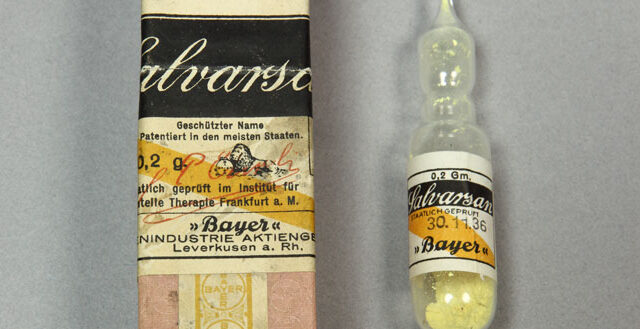In the 19th century arsenic was often the poison of choice for murderers. In the early 20th century its image was redeemed when an arsenic derivative became the salvation of those suffering from syphilis.
A bacterial infection primarily spread through sexual contact, syphilis has long been a feared disease. (Suspected sufferers throughout history include Henry VIII, Vincent van Gogh, and Adolf Hitler.) The first symptom is usually a small, open sore, followed by a pustular rash that can spread all over the body. In its late stage, which can take anywhere from five to forty years to reach, syphilis may attack the central nervous system; the worst cases result in paralysis, dementia, seizures, and sometimes death. Historic treatments—usually toxic mercury compounds—were often worse than the disease itself and produced many of the same symptoms as advanced syphilis.
But in 1909 German chemist Paul Ehrlich and his team of researchers developed a chemical compound to treat syphilis effectively. Ehrlich and his partners, organic chemist Alfred Bertheim and bacteriologist Sahachiro Hata, experimented with hundreds of synthesized compounds until finding success in number 606, which would later be called Salvarsan. The drug came to market in 1910.
Ehrlich’s compound, a synthetic derivative of arsenic, successfully treated the early and middle stages of infection. Though no one knew exactly how the drug worked, it did kill the syphilis-causing bacteria without poisoning the patient, leading Ehrlich to call his drug a “magic bullet.” Salvarsan quickly became the treatment of choice for syphilis and remained so until replaced by penicillin.
Nonetheless, Salvarsan was not without its problems. Patients with late-stage syphilis did not respond as well to treatment. Doctors and nurses found handling the drug difficult: the powder was unstable in air and needed careful preparation before being injected into patients. In the 1940s, with the growing availability of antibiotics, Salvarsan was abandoned for more effective and easier-to-handle drugs.
In June 2011 CHF received a donation of an early sample of Salvarsan. Dated November 30, 1936, it can be traced back to Ehrlich’s research laboratory, which continued chemotherapy research after Ehrlich’s death in 1915. The sample belonged to two German-Jewish dermatologists, Felix Pinkus and his father Hermann, who used the compound in their practice. After the Nazis took power the two fled to the United States, taking their supply of Salvarsan with them.
Syphilis infections declined in the United States throughout the 20th century, and the life-threatening tertiary stage became almost unheard of. Over the past few years syphilis rates have been increasing, with the disease now the third most common sexually transmitted infection in the nation. Some researchers suspect that improvements in medical treatment have created a false sense of security. While there are no “magic bullets,” Ehrlich’s discovery still remains a milestone in the history of medicine.
Editor’s note: This article has been revised from the original to more accurately portray the preparation method of Salvarsan.




